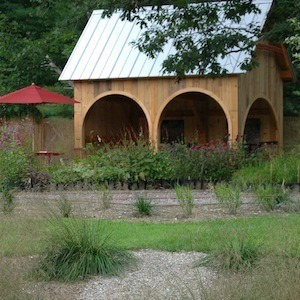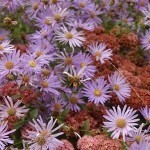About Us
We are a specialty nursery growing herbaceous ornamental wildflowers, grasses, and select hybrids and cultivars. In creating our plant selection particular attention has been given to plants that are hardy, robust-growing, and low-maintenance while embodying a more natural and wild aesthetic. It is this very same selection of plants we as designers use to practice the art of naturalistic planting design. Our sales approach is hands-on, and we go to great lengths to help customers understand the plants in our nursery from both an ecological and design perspective, often resulting in a personal consultation concerning the development of their garden, and a tour of the nursery’s display gardens.
 Naturalistic Planting Design
Naturalistic Planting Design
Nature is in a state of constant and dynamic change from season to season. Our focus is on herbaceous perennial plants which reflect this change while remaining beautiful, keeping our gardens attractive from spring into winter, what is known as a “long season of interest”. Ultimately we chose to grow a particular plant not for its rarity or popularity but for the artistic effect it contributes to the garden as a whole. In harsher climates such as in Maine, plant foliage and structure play a particularly important role in the garden as it is with us over a longer period, and color is best seen as an important yet added extra.
We are keenly aware of the ongoing effort in the commercial plant industry to entice the public with an ever-increasing selection of plants. In our opinion, newly introduced hybrids and cultivars are often no better than already existing tried and true forms or species, and this effort often leads to confusing the gardener rather than enlightening. From these new introductions, we pick and choose carefully. One exception is the renewed interest and introduction of native plant cultivars which we believe is a very promising and beneficial trend. Professional trials for certain important genera can be found at the link to Mt. Cuba Center. That said, we actively select new plants for our nursery. These new selections are not only the result of the genetic diversity found within the seeds we sow but of our ‘plant hunting’ effort when from season to season we explore different local habitats to find indigenous plants with unique qualities. As new introductions, such plants have the added benefit of potentially helping to support a wider array of wildlife while introducing new possibilities in design. When looking through our plant selection, a description with the words “A local selection” means it has been propagated from local genetic stock within a roughly 30-mile radius of the nursery. A visit to the ocean and the shores and tributaries of Merrymeeting Bay, as well as fragments of sandplain grassland, and open woodlands, each with their unique and diverse flora, provide untold inspiration.
 For us, naturalistic planting design is an aesthetic grounded in the natural world, and we look for inspiration as much in the spontaneity of natural areas as we do in highly designed gardens. No matter the source of our inspiration, gardening is always a living process that requires not only artistic vision but a basic understanding of the scientific disciplines of ecology, biology, and botany, which altogether makes it wholly unique as an art form. Complete artistic expression is not yet achieved until all those creatures that flutter and buzz, creep and crawl, find refuge in the plantings we create, not only for us, but for them. As both gardeners and nature lovers, our goal is to inspire and encourage imagination in the art of garden creation with respect to the dynamic beauty and emotion of nature.
For us, naturalistic planting design is an aesthetic grounded in the natural world, and we look for inspiration as much in the spontaneity of natural areas as we do in highly designed gardens. No matter the source of our inspiration, gardening is always a living process that requires not only artistic vision but a basic understanding of the scientific disciplines of ecology, biology, and botany, which altogether makes it wholly unique as an art form. Complete artistic expression is not yet achieved until all those creatures that flutter and buzz, creep and crawl, find refuge in the plantings we create, not only for us, but for them. As both gardeners and nature lovers, our goal is to inspire and encourage imagination in the art of garden creation with respect to the dynamic beauty and emotion of nature.
Display/Demonstration Gardens
Campo di Fiori and its three different display gardens is not only a showcase for the natural beauty of plants but a place of ongoing experimentation in designing with them. Every year and every season is different, and these gardens, like all gardens, are by nature forever works-in-progress.
Perennial Meadow
Traveling past the sales area and through the white pine hedge is the largest display garden known as the Perennial Meadow. Here is the greatest diversity of plants with strong and long-lasting structures artistically juxtaposed in an informal, open-border, matrix, or meadow-like planting. The heavy clay loam supports large clumps of Calamagrostis, Eupatorium, Panicum, and Vernonia along the back, and in the middle and foreground is a semi-matrix dominated of the grass Sesleria with intermingled clumps of Sedum, Allium, Liatris, Echinacea, Persicaria, Penstemon, and Zizia, among several others. This garden is at its height of visual interest from late spring into late fall. A path runs through and behind the deepest parts of the meadow allowing one to immerse themselves amongst the plants and to experience the planting more intimately and from different angles.
Deschampsia Meadow
This garden is located in and around the lower nursery area and parking lot and is a minimalistic matrix-type planting that mimics a meadow or other type of open habitat such as prairie or steppe (or roadside), both dominated by grasses and forbs. The planting is largely dominated by the Deschampsia caespitosa cultivar ‘Bronzeschlier’, a native ornamental grass, from which emerge the perennials Rudbeckia maxima Digitalis ferruginea, among others.
Carex Woodland Meadow
This garden is located in the upper nursery area and is yet another example of a matrix-type planting but for dry semi-shade. Here Carex muskingumensis, an ornamental sedge native to the Great Lakes region, is the primary matrix plant that creates the woodland meadow-like feel. Species of Carex are particularly reliable and effective when put to this use. Under the part-shade (and roots) of a giant red oak, in well-drained silt loam soil, we are challenged to make a shade garden for our times, one that is adapted to our increasingly dry summers, the ubiquity of shade that prevails in heavily forested Maine, and remains attractive through the seasons. So many beautiful native woodland species from around the world are spring-flowering ephemeral plants of moist humus-rich soils, which unfortunately in midcoast Maine, are becoming a rarity. In our ongoing trials with this difficult garden location, we have discovered that many of the best plants for this site are native – plants such as Geranium maculatum, Gillenia trifoliata, and Smilicina racemosa. Combined with other tough non-native plants such as Hellebore, Hosta, and the large structural clumps of the grass Spodiopogin sibiricus, the garden has become a unique example. A sitting area in the middle of this meadow overlooks the wild meadows which are the foreground to the Cathance River wetland.
Nature Walk
For those interested in nature study or just wanting to take a walk, a mown path provides an opportunity to explore the fields and edges of the designated conservation land surrounding the nursery and the Cathance River. In mid-summer one may find the less common Plantathera lacera or Smilax herbacea hiding amongst the grasses, and much more likely the ubiquitous yet attractive non-natives Trifolium pratense, Ranunculus acris, and Chrysanthemum leucanthemum. Bluebirds, bobolinks, tree and barn swallows, and a nesting pair of bald eagles are species of birds often seen utilizing and nesting in or around the fields. From here the very adventurous may make their way onto the abandoned railroad bed and walk along and through the middle of the wetland and riparian areas adjoining the river where a whole other mix of native plants occurs and may be viewed up close – Eupatorium, Lobelia, Lysimachia, and Lilium canadense to name a few.
The nursery, Campo di Fiori, is dedicated in memoriam to Andrew’s grandmother, Lucille Jewell, long-time gardener and caretaker of the family farm, avid botanist and bird-watcher, founding member of Merrymeeting Audobon, and long-time member of Josselyn Botanical Society, Sorrento Scientific Society, and Friends of Merrymeeting Bay. May these things in nature which she loved be allowed to persist for eternity.
“For many gardeners, what we enjoy most about gardening is not so much what we grow as who we become. We gardeners are healthy, joyous, natural creatures. We are practical, patient, optimistic. We declare our optimism every year, every season, with every act of planting. We engage in regular, purposeful exercise. We notice everything. We accept everything. We use everything that comes our way. We feel the birth and ebb and flow of everything. We are part of the pattern. We are rooted firmly in the natural world, as aware of the plants, soil, winds, and weather as any other natural thing. We gardeners are fully connected to the land of our living.”
Carol Deppe, The Resilient Gardener


